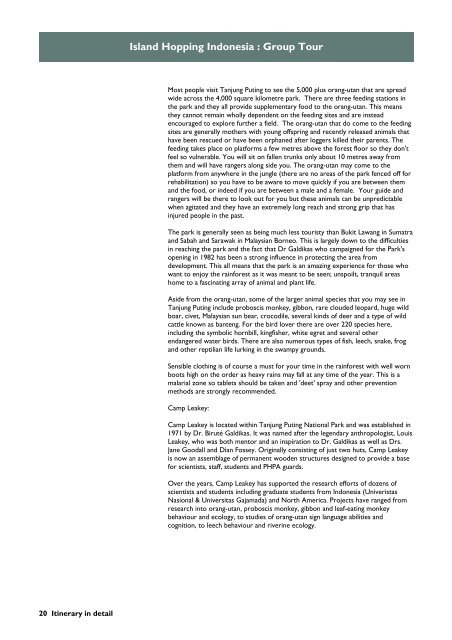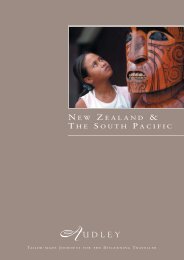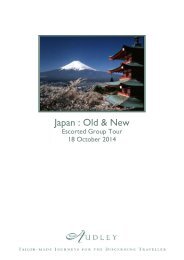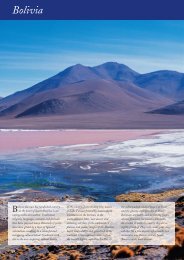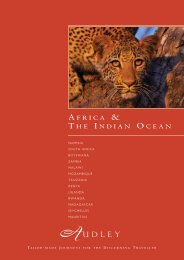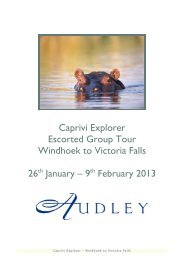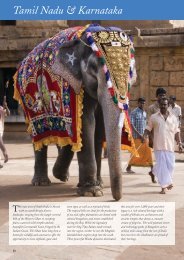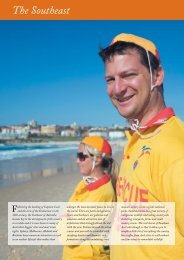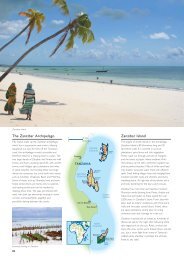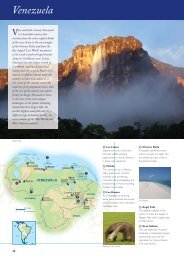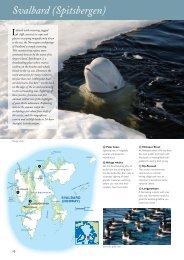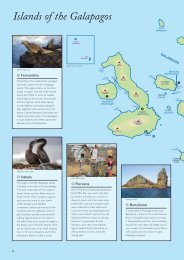Island Hopping Indonesia - Audley Travel
Island Hopping Indonesia - Audley Travel
Island Hopping Indonesia - Audley Travel
- No tags were found...
You also want an ePaper? Increase the reach of your titles
YUMPU automatically turns print PDFs into web optimized ePapers that Google loves.
<strong>Island</strong> <strong>Hopping</strong> <strong>Indonesia</strong> : Group TourMost people visit Tanjung Puting to see the 5,000 plus orang-utan that are spreadwide across the 4,000 square kilometre park. There are three feeding stations inthe park and they all provide supplementary food to the orang-utan. This meansthey cannot remain wholly dependent on the feeding sites and are insteadencouraged to explore further a field. The orang-utan that do come to the feedingsites are generally mothers with young offspring and recently released animals thathave been rescued or have been orphaned after loggers killed their parents. Thefeeding takes place on platforms a few metres above the forest floor so they don'tfeel so vulnerable. You will sit on fallen trunks only about 10 metres away fromthem and will have rangers along side you. The orang-utan may come to theplatform from anywhere in the jungle (there are no areas of the park fenced off forrehabilitation) so you have to be aware to move quickly if you are between themand the food, or indeed if you are between a male and a female. Your guide andrangers will be there to look out for you but these animals can be unpredictablewhen agitated and they have an extremely long reach and strong grip that hasinjured people in the past.The park is generally seen as being much less touristy than Bukit Lawang in Sumatraand Sabah and Sarawak in Malaysian Borneo. This is largely down to the difficultiesin reaching the park and the fact that Dr Galdikas who campaigned for the Park'sopening in 1982 has been a strong influence in protecting the area fromdevelopment. This all means that the park is an amazing experience for those whowant to enjoy the rainforest as it was meant to be seen; unspoilt, tranquil areashome to a fascinating array of animal and plant life.Aside from the orang-utan, some of the larger animal species that you may see inTanjung Puting include proboscis monkey, gibbon, rare clouded leopard, huge wildboar, civet, Malaysian sun bear, crocodile, several kinds of deer and a type of wildcattle known as banteng. For the bird lover there are over 220 species here,including the symbolic hornbill, kingfisher, white egret and several otherendangered water birds. There are also numerous types of fish, leech, snake, frogand other reptilian life lurking in the swampy grounds.Sensible clothing is of course a must for your time in the rainforest with well wornboots high on the order as heavy rains may fall at any time of the year. This is amalarial zone so tablets should be taken and 'deet' spray and other preventionmethods are strongly recommended.Camp Leakey:Camp Leakey is located within Tanjung Puting National Park and was established in1971 by Dr. Biruté Galdikas. It was named after the legendary anthropologist, LouisLeakey, who was both mentor and an inspiration to Dr. Galdikas as well as Drs.Jane Goodall and Dian Fossey. Originally consisting of just two huts, Camp Leakeyis now an assemblage of permanent wooden structures designed to provide a basefor scientists, staff, students and PHPA guards.Over the years, Camp Leakey has supported the research efforts of dozens ofscientists and students including graduate students from <strong>Indonesia</strong> (UniveristasNasional & Universitas Gajamada) and North America. Projects have ranged fromresearch into orang-utan, proboscis monkey, gibbon and leaf-eating monkeybehaviour and ecology, to studies of orang-utan sign language abilities andcognition, to leech behaviour and riverine ecology.20 Itinerary in detail


